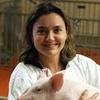Particle size distribution of airborne PRRS and PED viruses emitted by infected animals inside and outside swine facilities
Published: July 19, 2023
By: C. Alonso 1,*, M. Torremorell 1, S. Goyal 2, P. Davies 1, P. Raynor 3 / 1 Veterinary Population Medicine; 2 Veterinary Diagnostic Lab; 3 Division of Environmental Health Science, University of Minnesota, St. Paul, United States.
Summary
Keywords: Air samplers, Particle size, Viral aerosols
Introduction:
Porcine reproductive and respiratory syndrome (PRRS) and porcine epidemic diarrhea (PED) viruses are airborne pathogens able to spread rapidly regionally. Despite this evidence, the information on the size of particles with which airborne viruses are associated while airborne in the field is limited. This association will determine the virus contribution to the airborne route, will help to explain the in between-farm transmission, as well as the survivability/infectivity of the viruses in aerosols. Thus, the objective of this study was to characterize the size distribution of the particles that transport PRRSV and PEDV generated by acutely infected pigs under field conditions.
Materials and Methods:
Farms in Minnesota experiencing active outbreaks of PRRSV or PEDV were enrolled in the study during the winter of 2014-15. Two and 3 replicates of air samples/ room were collected for 1h using an 8 staged Andersen cascade impactor (ACI, 28.3 lpm) and for 15min using a 5 staged high volume Tisch cascade impactor (TCI, 1,100 lpm), respectively. Both air samplers,are capable to collect inhalable particles as function of particle size (from 0.01-10μ). Samples were collected inside and at 5m outside the farms. Additionally, an optical particle counter was used to analyze total airborne particles during the sampling periods. Samples were analyzed by quantitative PRRSV and PEDV RT-PCR. Log of total quantity of RNA virus/m3 of air, and total particle counts by size and type of virus were analyzed for the study.
Results:
A total of 210 air samples from 4 nurseries were analyzed by quantitative RT-PCR. PEDV farms had no clinical signs at the time of sampling; however it was detected in the air in all particle sizes measured inside and outside and in higher quantities than PRRSV. Inside, PEDV was detected in quantities ranging from 2.8 logs (particles between 0.7-1.1µm) to 6.25 logs (4.7-5.8µm). PRRSV, was detected in all size ranges, except for particles < 2.1µm (limit of qPCR detection was added for calculations) in quantities ranging from 2.4 (2.1-3.3µm particles) to 5.4 logs (particles > 9.0µm). All samples collected outside were negative for PRRSV.
Conclusion:
Results from this study indicate that PEDV and PRRSV can be found in a wide range of particle sizes while airborne under field conditions, however, PRRSV seems to be essentially associated to larger particles. PRRSV airborne particles were not detected outside the swine facilities. This information is important to further our understanding of airborne transmission and to evaluate the efficacy and impact of biosecurity measures such as air filtration on the risk of pathogen introduction in filtered farms.
Disclosure of Interest: None Declared.
Published in the proceedings of the International Pig Veterinary Society Congress – IPVS2016. For information on the event, past and future editions, check out https://ipvs2024.com/.
Content from the event:
Related topics:
Authors:
University of Minnesota
University of Minnesota
University of Minnesota
Recommend
Comment
Share

Would you like to discuss another topic? Create a new post to engage with experts in the community.








